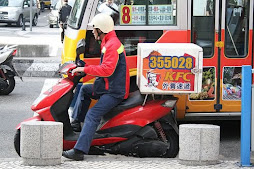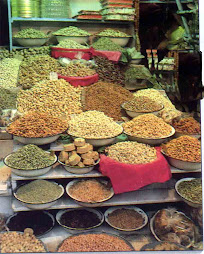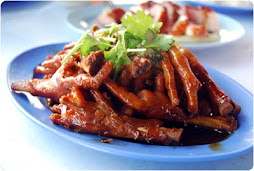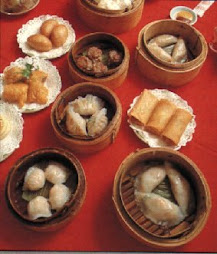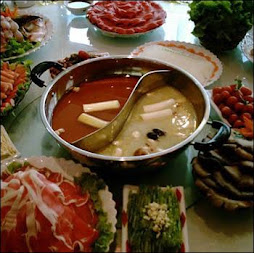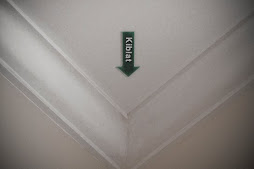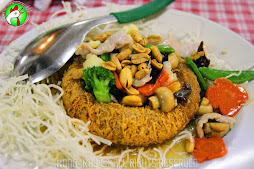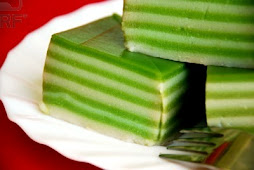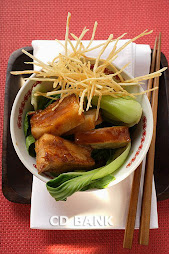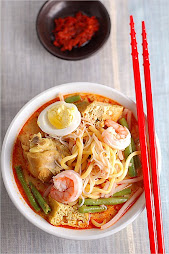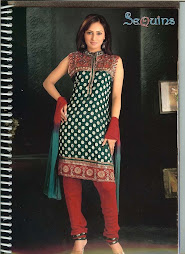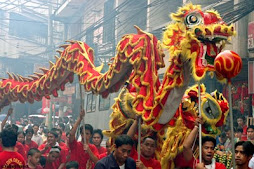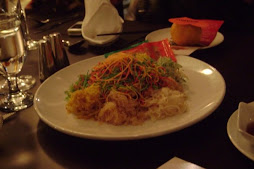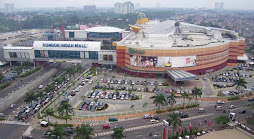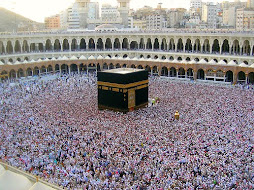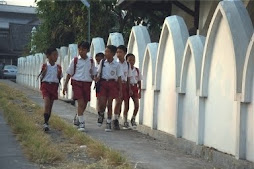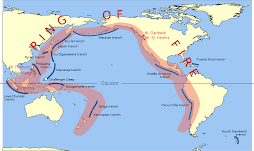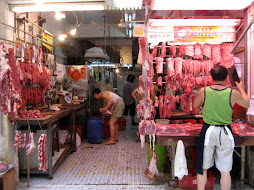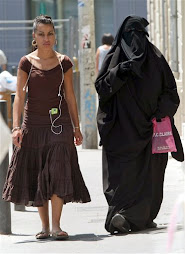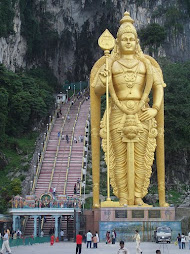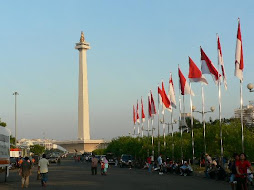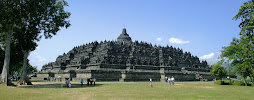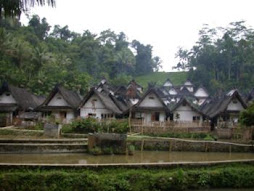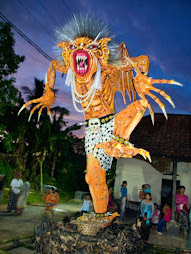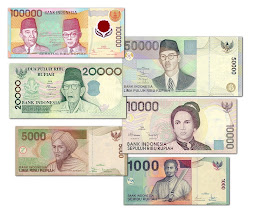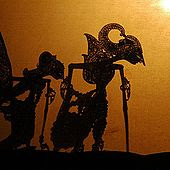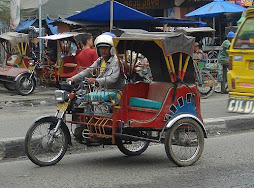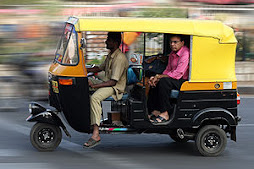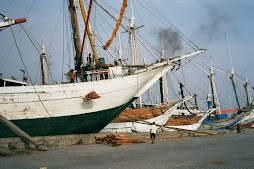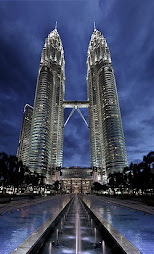What type of fast food can you get and is it the same as you can have here?
ANSWER: The Western World has a huge impact on Asian culture. We have all the same fast food places as home: McDonalds, Pizza Hut, Dominoe's, Burger King, Popeyes, Wendys, Dunkin Donuts, A&W's, KFC, and Baskin Robbins. The difference is that they all deliver to your house (except Dunkin Donuts, Baskin Robbins, and A&W, but I'm sure for the right price they would), most of the time 24 hours a day/7 days a week (see photo). Can you imagine getting McDonalds delivered anytime, day or night? It's pretty cool, especially if you're up late and hungry. Another difference that I'm noticing with these places especially in Indonesia is that KFC doesn't serve mashed potatoes, instead they serve rice (remember how I said rice is a staple with every meal including breakfast). And almost all of the places that serve burgers, also serve fried chicken. I'm hoping one day, somebody will make my dream come true and open up a Taco Bell.
We also have other restaurants that are from the U.S. There is Outback, Chili's, and TGIF. When we're in the mood for a dinner that is familiar and we don't have to worry about if it's going to be spicy or not, we go to one of those.
Sunday, May 16, 2010
Question from Christian
What is the average cost of rent there?
ANSWER: Well, honestly I can only answer this question as an expat. I was recently house hunting and even though the company pays our rent, I wanted to find the perfect house at the right price. We are allocated a certain amount each month for housing and even if our rent is lower than that amount then the company will still pay us the difference which we can use to pay for our utilities, cable, internet, maid, gardener, and security or we can save it.
There are many housing options for expats living in Jakarta. You can choose an apartment and then it could be a serviced apartment where they provide house keeping and laundry service, the apartment could be unserviced but still have amenities such as swimming pool, gym, sauna, restaurant, and security; or you could choose a penthouse which is just a larger, usually 2-leveled apartment. The prices for these usually start at $1000 p/month and can go as high as (depending on the size of your apartment) as $5000 p/month.
If you choose to live in a house, there are several options for that as well. You could have a townhouse that is usually located in a complex with 24 hour security, you could have an individual house that is located in a compound with amenities and 24 hour security, or you could live in an individual house and hire your own private security which is what we chose to do. The prices vary depending on which area you want to live in, the amenities offered, if it's furnished or unfurnished, and how updated the house is. It can average anywhere from $1000 p/month up to $10,000, the higher price of course is more than likely for a mansion so size does matter in the price too. The house I chose is in a good neighborhood, 3 bedrooms, 3 bathrooms, updated kitchen and bathrooms, a front yard, back yard with swimming pool, and is about 3200 sq/feet and our rent is 25 million rupiah p/month or $2500. Keep in mind that most landlords know that expats will be renting their properties so they of course increase the price plus they ask for a full years rent up front plus security deposit, but they know that the company is paying for it so they have no problem doing that.
Of course we would never pay these prices if we were home and I'm sorry I don't know what the locals pay for rent, no matter how much research I did, I could only find numbers for expats cost of living. But I'm happy with the house and can't wait to move in at the end of this month.
ANSWER: Well, honestly I can only answer this question as an expat. I was recently house hunting and even though the company pays our rent, I wanted to find the perfect house at the right price. We are allocated a certain amount each month for housing and even if our rent is lower than that amount then the company will still pay us the difference which we can use to pay for our utilities, cable, internet, maid, gardener, and security or we can save it.
There are many housing options for expats living in Jakarta. You can choose an apartment and then it could be a serviced apartment where they provide house keeping and laundry service, the apartment could be unserviced but still have amenities such as swimming pool, gym, sauna, restaurant, and security; or you could choose a penthouse which is just a larger, usually 2-leveled apartment. The prices for these usually start at $1000 p/month and can go as high as (depending on the size of your apartment) as $5000 p/month.
If you choose to live in a house, there are several options for that as well. You could have a townhouse that is usually located in a complex with 24 hour security, you could have an individual house that is located in a compound with amenities and 24 hour security, or you could live in an individual house and hire your own private security which is what we chose to do. The prices vary depending on which area you want to live in, the amenities offered, if it's furnished or unfurnished, and how updated the house is. It can average anywhere from $1000 p/month up to $10,000, the higher price of course is more than likely for a mansion so size does matter in the price too. The house I chose is in a good neighborhood, 3 bedrooms, 3 bathrooms, updated kitchen and bathrooms, a front yard, back yard with swimming pool, and is about 3200 sq/feet and our rent is 25 million rupiah p/month or $2500. Keep in mind that most landlords know that expats will be renting their properties so they of course increase the price plus they ask for a full years rent up front plus security deposit, but they know that the company is paying for it so they have no problem doing that.
Of course we would never pay these prices if we were home and I'm sorry I don't know what the locals pay for rent, no matter how much research I did, I could only find numbers for expats cost of living. But I'm happy with the house and can't wait to move in at the end of this month.
Question from jabari
You talked about the spices used there, what is the most popular spice to put into food?
ANSWER: Indonesia is known for cloves and nutmeg and was the reason for so many ancient wars, over who would control the Spice Islands. First it was dominated by Chinese, Indian and Arab merchants then the Europeans came to Indonesia looking for cloves and nutmeg since it was widely used by women to freshen their breath, men used to put in drinks and also it was used for medicinal purposes like for the treatment of rheumatism, gout, and colic. When the Europeans arrived, Indonesia was controlled by Portuguese and they were fighting the Spaniards who were fighting the natives. Eventually everyone lost, and Indonesia was ruled by the Dutch from 1605-1945 when Indonesia gained its independence.
Indonesia taught the world the use of exotic spices and herbs. Indonesian cuisine is known for its deliberate combination of contrasting flavors (spicy, sour, sweet, hot) and textures (wet, coarse, spongy, hard). Indonesian saffron (kunyit) is used to color rice dishes an intense yellow and provide rice with spicy flavoring. Terasi, a red-brown fermented shrimp paste with a potent aroma, is used in small amounts in most sauces. It's considered absolutely essential to a successful rijstaffel (smorgasboard). There are many kinds of hot chili pastes (sambal) invariably made from red chilies, shallots, and tomatoes. So, really there really isn't just one popular spice that's used in Indonesia, it's the combination of the spices that give Indonesian dishes their unique flavor.
ANSWER: Indonesia is known for cloves and nutmeg and was the reason for so many ancient wars, over who would control the Spice Islands. First it was dominated by Chinese, Indian and Arab merchants then the Europeans came to Indonesia looking for cloves and nutmeg since it was widely used by women to freshen their breath, men used to put in drinks and also it was used for medicinal purposes like for the treatment of rheumatism, gout, and colic. When the Europeans arrived, Indonesia was controlled by Portuguese and they were fighting the Spaniards who were fighting the natives. Eventually everyone lost, and Indonesia was ruled by the Dutch from 1605-1945 when Indonesia gained its independence.
Indonesia taught the world the use of exotic spices and herbs. Indonesian cuisine is known for its deliberate combination of contrasting flavors (spicy, sour, sweet, hot) and textures (wet, coarse, spongy, hard). Indonesian saffron (kunyit) is used to color rice dishes an intense yellow and provide rice with spicy flavoring. Terasi, a red-brown fermented shrimp paste with a potent aroma, is used in small amounts in most sauces. It's considered absolutely essential to a successful rijstaffel (smorgasboard). There are many kinds of hot chili pastes (sambal) invariably made from red chilies, shallots, and tomatoes. So, really there really isn't just one popular spice that's used in Indonesia, it's the combination of the spices that give Indonesian dishes their unique flavor.
Question from Isela
Have you been to any interesting restaurants in Asia?
ANSWER: We have been to many interesting places to eat in Asia. I think what makes them interesting is the food that they serve although a couple have offered us different dining experiences. One of the first different experiences we had was when we visited Shanghai, China. It was a place called the Hot Pot (see photo), the Chinese friends that took us did all of the ordering for us and the wait staff brought over a large pot that had 2 sections filled with different broths. This pot was over a burner to heat the broth and then the wait staff brought us various raw meats and vegetables and we could choose the ones we wanted to cook ourselved in the broth. Then once the meat and vegetables are finished cooking, you fish them out with your chopsticks and dip them in a spicy peanut sauce. It was a fun experience and tasty!
My husband and I have grown fond of dim sum also. This is a type of Chinese dish that involves small individual portions of food, usually served in a small steamer basket or on a small plate (see photo). Dim sum is traditionally served at tea time (early afternoon) and is a perfect snack to hold you over before dinner. Dim sum can be many different things, but usually it's a steamed dumpling filled with either pork, shrimp, or vegetables and it's of course served with Chinese tea. In addition to the dumplings there's also buns filled with BBQ pork called Bau, rice noodles, meatballs, spare ribs, spring rolls, and chicken feet. The chicken feet are called Phoenix Talons and they are deep fried, then boiled, then marinated in a black bean sauce, then steamed; a lot of people eat chicken feet for breakfast, me personally I don't think they have enough meat on them (see photo). In addition, there are also cakes and pudding for dessert. Even though it's custom to eat dim sum at tea time or early in the morning, there are many restaurants who serve it for dinner as well.
Even though I've tried different foods since living in Asia, and have been to many restaurants, nothing beats a good hawker stall or hawker center. I've mentioned the numerous street peddlars here in Jakarta but in Malaysia, Singapore and Shanghai, they are called hawkers and an area where there are many hawkers it called a hawker center (see photo), in Jakarta they are called Warungs (wah-roongs). These are people who have been selling their food on the streets for generations and use their family's or village's recipes. Some of the best food I've had comes from these places. I haven't tried any yet in Jakarta, I'll wait until we move into our permanent house and then find one with good food and is somewhat clean.
ANSWER: We have been to many interesting places to eat in Asia. I think what makes them interesting is the food that they serve although a couple have offered us different dining experiences. One of the first different experiences we had was when we visited Shanghai, China. It was a place called the Hot Pot (see photo), the Chinese friends that took us did all of the ordering for us and the wait staff brought over a large pot that had 2 sections filled with different broths. This pot was over a burner to heat the broth and then the wait staff brought us various raw meats and vegetables and we could choose the ones we wanted to cook ourselved in the broth. Then once the meat and vegetables are finished cooking, you fish them out with your chopsticks and dip them in a spicy peanut sauce. It was a fun experience and tasty!
My husband and I have grown fond of dim sum also. This is a type of Chinese dish that involves small individual portions of food, usually served in a small steamer basket or on a small plate (see photo). Dim sum is traditionally served at tea time (early afternoon) and is a perfect snack to hold you over before dinner. Dim sum can be many different things, but usually it's a steamed dumpling filled with either pork, shrimp, or vegetables and it's of course served with Chinese tea. In addition to the dumplings there's also buns filled with BBQ pork called Bau, rice noodles, meatballs, spare ribs, spring rolls, and chicken feet. The chicken feet are called Phoenix Talons and they are deep fried, then boiled, then marinated in a black bean sauce, then steamed; a lot of people eat chicken feet for breakfast, me personally I don't think they have enough meat on them (see photo). In addition, there are also cakes and pudding for dessert. Even though it's custom to eat dim sum at tea time or early in the morning, there are many restaurants who serve it for dinner as well.
Even though I've tried different foods since living in Asia, and have been to many restaurants, nothing beats a good hawker stall or hawker center. I've mentioned the numerous street peddlars here in Jakarta but in Malaysia, Singapore and Shanghai, they are called hawkers and an area where there are many hawkers it called a hawker center (see photo), in Jakarta they are called Warungs (wah-roongs). These are people who have been selling their food on the streets for generations and use their family's or village's recipes. Some of the best food I've had comes from these places. I haven't tried any yet in Jakarta, I'll wait until we move into our permanent house and then find one with good food and is somewhat clean.
Question from Hank
Do you know the countries GDP?
ANSWER: Indonesia's nominal GDP is forecast to be US 614.55 billion for 2010. This is contributed to retail sales, tourism, and food consumption as well as exportation of oil products and agriculture. Average annual GDP growth of 5.6% is predicted through to 2014 since the population is also anticipated to rise to 250 million people by 2014. Indonesia has one of the largest economies in S.E. Asia and is one of the emerging market economies of the world.
Malaysia's GDP as of 2009 was US 381.1 billion. This is contributed to agriculture, export of rubber, oil products, timber, palm oil and the manufacture and export of electronics and electrical equipment to the U.S., Malaysia's principal trade and investment partner. Malaysia is ranked 24th in terms of world oil reserves and 13th for natural gas.
ANSWER: Indonesia's nominal GDP is forecast to be US 614.55 billion for 2010. This is contributed to retail sales, tourism, and food consumption as well as exportation of oil products and agriculture. Average annual GDP growth of 5.6% is predicted through to 2014 since the population is also anticipated to rise to 250 million people by 2014. Indonesia has one of the largest economies in S.E. Asia and is one of the emerging market economies of the world.
Malaysia's GDP as of 2009 was US 381.1 billion. This is contributed to agriculture, export of rubber, oil products, timber, palm oil and the manufacture and export of electronics and electrical equipment to the U.S., Malaysia's principal trade and investment partner. Malaysia is ranked 24th in terms of world oil reserves and 13th for natural gas.
Question from Jackie
Do they read the same direction that we do?
ANSWER: Ok, not sure if I'm reading this correctly but if you mean like reading books and magazines, then yes, they read in the same direction as we do. I know in some languages like Hebrew, which reads from right to left, and Mandarin, which reads vertically, but Bahasa Indonesia reads left to right just like at home. Since Indonesia is a former Dutch colony, they also have the same alphabet as we do but the letters are pronounced differently.
If you meant in terms of direction, then, they use North, South, East, and West as well.
ANSWER: Ok, not sure if I'm reading this correctly but if you mean like reading books and magazines, then yes, they read in the same direction as we do. I know in some languages like Hebrew, which reads from right to left, and Mandarin, which reads vertically, but Bahasa Indonesia reads left to right just like at home. Since Indonesia is a former Dutch colony, they also have the same alphabet as we do but the letters are pronounced differently.
If you meant in terms of direction, then, they use North, South, East, and West as well.
Question from LaDorria
What is the health care like there?
ANSWER: Well, to put it simply: it's lacking. Basicly, if you can afford good healthcare then you can go to acredited hospitals where the staff of doctors have more than likely trained overseas. If you can not afford to go to these hospitals then there are many clinics that offer treatment but it's not guaranteed that you'll be diagnosed correctly or treated properly. They say most of the doctors who operate in such clinics have bought their medical degrees and the methods in which they practice are outdated. As of now, there are no government sponsored programs so people either receive poor treatment or medicate themselves, this is true for those who live in rural areas where clinics are few. A lot of people who can afford good treatment choose to travel to Singapore or Malaysia, believing that the doctors and facilities are modern and techniques are up to date. The government is planning over the next 4 years to implement a system for the poor, elderly and disabled but people are again doubting the quality of care that they will receive. The hospital that I plan on using is very modern and clean and so far I have no doubts that I will receive adequate care for my diabetes. I recently went to a dentist to have a tooth pulled and I must say that it was probably the best experience I've ever had at a dentist's office. The office was clean and used modern techniques and the cost was cheaper than what I would have paid in the U.S., only $100. But if you're local and you only make $150 p/month, then you would not choose this office since it's considered expensive.
There are community organizations that sponsor clinics here. On my trip to Medan, Indonesia, I was with my Malaysian friend and her mother who is a member of the Rotary Club. We stopped in a village so that we could dedicate a free clinic to the community. I must say, even though I had nothing to do with the clinic itself, it was a good feeling leaving there and knowing that the people would have access to a doctor and a dentist free of charge. As a matter of fact, my friend Sim was their very first dental patient since she had her wisdom pulled before the trip and she was very swollen so the dentist had a look (see photo).
ANSWER: Well, to put it simply: it's lacking. Basicly, if you can afford good healthcare then you can go to acredited hospitals where the staff of doctors have more than likely trained overseas. If you can not afford to go to these hospitals then there are many clinics that offer treatment but it's not guaranteed that you'll be diagnosed correctly or treated properly. They say most of the doctors who operate in such clinics have bought their medical degrees and the methods in which they practice are outdated. As of now, there are no government sponsored programs so people either receive poor treatment or medicate themselves, this is true for those who live in rural areas where clinics are few. A lot of people who can afford good treatment choose to travel to Singapore or Malaysia, believing that the doctors and facilities are modern and techniques are up to date. The government is planning over the next 4 years to implement a system for the poor, elderly and disabled but people are again doubting the quality of care that they will receive. The hospital that I plan on using is very modern and clean and so far I have no doubts that I will receive adequate care for my diabetes. I recently went to a dentist to have a tooth pulled and I must say that it was probably the best experience I've ever had at a dentist's office. The office was clean and used modern techniques and the cost was cheaper than what I would have paid in the U.S., only $100. But if you're local and you only make $150 p/month, then you would not choose this office since it's considered expensive.
There are community organizations that sponsor clinics here. On my trip to Medan, Indonesia, I was with my Malaysian friend and her mother who is a member of the Rotary Club. We stopped in a village so that we could dedicate a free clinic to the community. I must say, even though I had nothing to do with the clinic itself, it was a good feeling leaving there and knowing that the people would have access to a doctor and a dentist free of charge. As a matter of fact, my friend Sim was their very first dental patient since she had her wisdom pulled before the trip and she was very swollen so the dentist had a look (see photo).
Subscribe to:
Posts (Atom)

